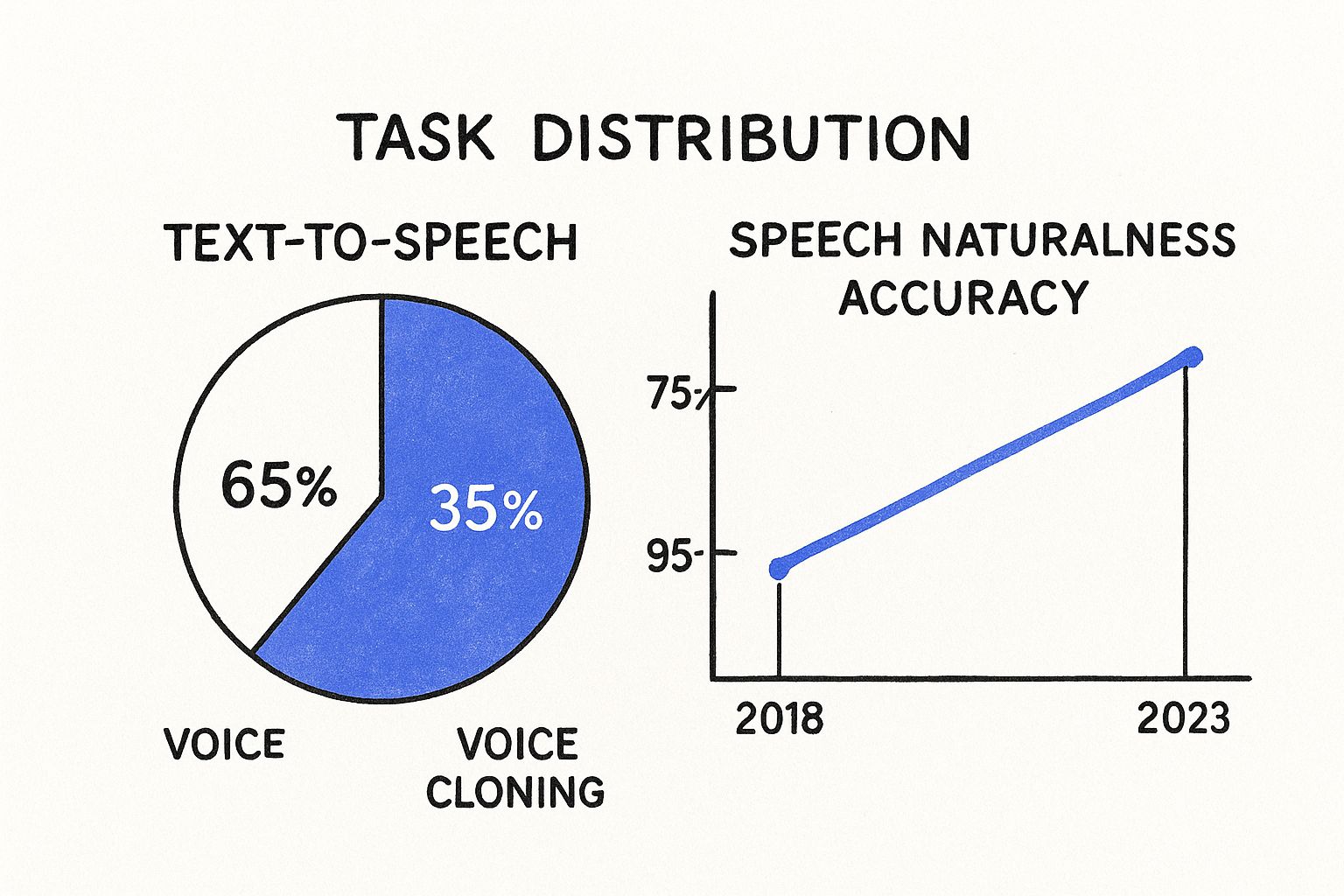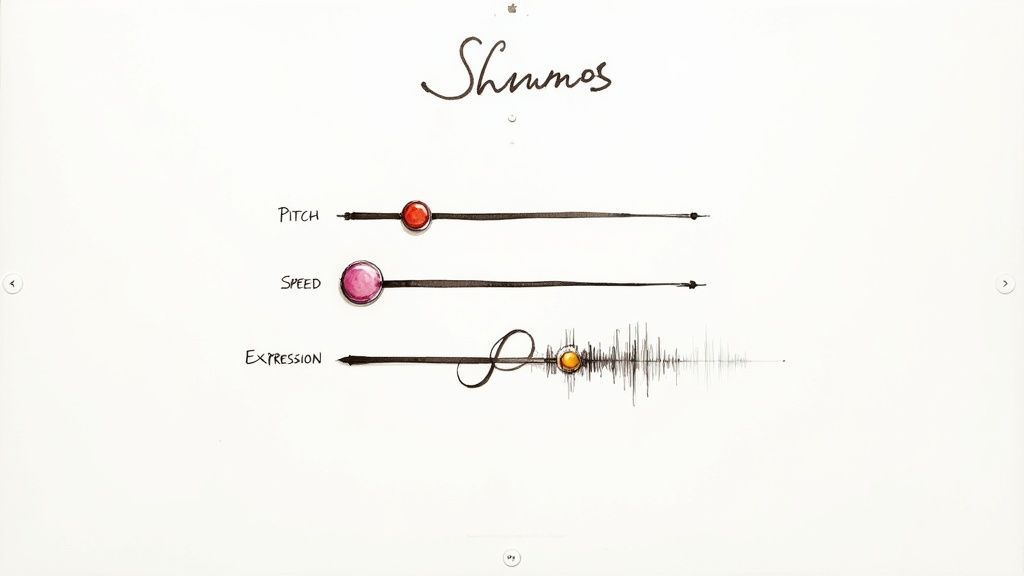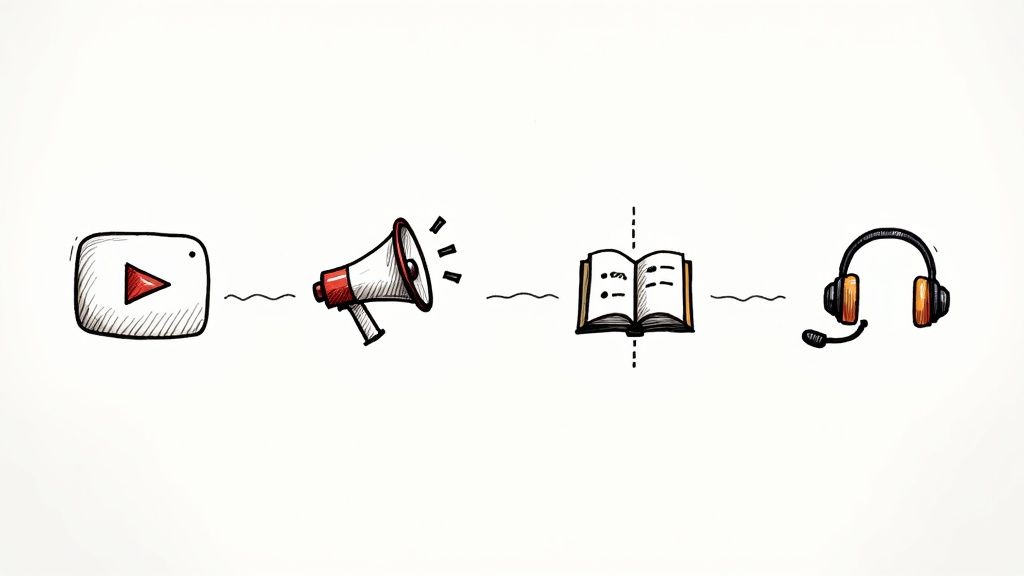Your Guide to the Best AI Voice Generator Tools

At its core, an AI voice generator is a tool that uses artificial intelligence to turn written words into speech that sounds incredibly human. Think of it as your own personal, on-demand digital voice actor, ready to create voiceovers for videos, podcasts, and presentations without you ever needing a microphone or a fancy studio. This guide provides actionable insights to help you leverage these tools effectively.
How AI Voice Generators Create Realistic Speech

Picture a talented musician looking at a piece of sheet music. They aren't just hitting the right notes; they're interpreting the tempo, the emotion, and the dynamics to truly bring the music to life. An AI voice generator does something remarkably similar, but its sheet music is your text, and its instrument is the human voice.
Instead of just spitting words out in a monotone drone, today's AI systems analyze your script for context, punctuation, and meaning. This allows them to generate speech with lifelike intonation, natural pauses, and subtle emotional shifts, turning plain text into a performance. We've come a long, long way from the robotic voices of the past.
This leap forward is all thanks to huge strides in machine learning, which have finally unlocked a new level of vocal realism.
The Rise of Synthetic Voices
The explosive growth in this space is impossible to ignore. The global AI voice generator market is currently sitting at USD 4.15 billion and is on track to hit an incredible USD 39.35 billion by 2032. This massive jump is driven by breakthroughs in how computers understand language and the simple fact that almost everyone has a smart device that relies on voice.
This isn't just a trend; it's a fundamental change in how we create and consume content. High-quality audio is no longer just for big-budget studios.
The core idea is simple yet powerful: make professional-grade audio production accessible to everyone. By understanding the underlying mechanics, you can better appreciate how these tools can fit into your creative workflow.
Making Advanced Technology Accessible
The engine behind this magic is a technology called text-to-speech (TTS). At its heart, TTS is what translates your written script into the audio you hear. If you want to get into the nitty-gritty, you can check out our full guide on what text-to-speech technology is and how it works.
This accessibility is exactly what makes platforms like Verbatik so powerful. By offering unlimited text-to-speech and voice cloning, we're tearing down the old barriers. Creators don't have to count characters or pay for every new audio clip, giving them the freedom to experiment, revise, and produce as much as they need. It’s about putting powerful tools directly into the hands of creators everywhere.
The Technology Behind Flawless AI Voices
So, what’s actually happening under the hood when you hit “generate” on an AI voice platform? It’s not magic, but it’s close. It’s a smart combination of two powerful technologies that work together to turn your script into audio that truly connects with listeners.
The first piece of the puzzle is Text-to-Speech (TTS). You can think of TTS as the engine that drives every AI voice. At its core, its job is to read text and turn it into spoken words. Simple enough, right?
But today’s TTS is way more sophisticated than the robotic voices of the past. It’s smart enough to analyze punctuation to add natural pauses, understand sentence structure to get the intonation just right, and even pick up on context for emphasis. If you want to get into the nitty-gritty, you can learn more about how text-to-speech technology works in our deep-dive guide. This is where having a tool that offers unlimited text to speech, like Verbatik, really pays off—you can create as much audio as you need without constantly checking your character count.
This chart gives you a quick look at how creators are using these technologies and just how far the quality has come in only a few years.

As you can see, TTS is the foundation for most projects. But that massive leap in quality is what paves the way for the next level of AI voice creation.
The Power of Voice Cloning
If TTS provides the voice, voice cloning gives it a soul. This is where AI voice generators move beyond generic narration and into truly personalized, branded audio. Voice cloning is exactly what it sounds like: creating a perfect digital copy of a specific person’s voice.
Imagine you’re launching a company podcast. You need the host’s voice to be perfectly consistent across dozens of episodes, even if they’re recorded months apart. Bringing a voice actor back into the studio for every small update is a logistical and financial nightmare. Voice cloning completely solves this.
The process is surprisingly straightforward. You just feed the AI a few minutes of audio from the voice you want to replicate. The system then gets to work, analyzing its unique vocal fingerprint:
- Pitch: The natural high and low tones.
- Timbre: The unique texture that makes a voice recognizable.
- Pacing: The rhythm and speed of their speech.
- Intonation: The subtle rise and fall in their voice that conveys meaning.
Once the AI has learned these vocal patterns, it can generate brand-new audio from any script you give it, all in that exact same voice. Your audio brand stays perfectly consistent, every single time.
Why Unlimited Access Changes Everything
The one-two punch of TTS and voice cloning is a creator's dream, but it often comes with a catch: limits. Many platforms operate on a pay-per-character or per-minute model, which forces you to be stingy with your creations. For anyone producing content at scale, this is a serious bottleneck.
This is where an unlimited model becomes a true creative asset. When you have access to both unlimited text to speech and voice cloning, you are free to experiment, iterate, and produce content at the scale your projects demand.
For instance, a marketing team can generate ten different versions of an ad read to see which one performs best, all without burning through their budget. A course creator can easily update lessons with fresh content using their own cloned voice, ensuring a seamless experience for their students.
At the end of the day, these two technologies are the pillars of any modern AI voice generator. TTS lays the foundation, and voice cloning builds a unique identity on top of it. With a platform like Verbatik, having unlimited access to both means you can finally stop counting characters and just focus on creating.
Must-Have Features in a Modern AI Voice Generator

Jumping into the world of AI voice generators can feel a bit like walking into a massive store with endless aisles. So many tools promise perfect, lifelike results, but what really separates a basic tool from a professional creative powerhouse? It all comes down to the features.
Knowing what to look for is the key to picking a platform that doesn't just work for today but scales with you tomorrow. After all, not all generators are created equal. A truly great one gives you the kind of fine-tuned control that turns a simple text-to-speech output into a genuinely captivating performance.
The Core Creative Toolkit
The heart of any great AI voice generator is its library and how much you can tweak it. A huge selection of voices is a good start, but the real magic happens when you can fine-tune every little detail of the performance. Without these controls, you’re stuck with a generic, one-size-fits-all voice that just won't cut it.
Here are the non-negotiables you should be looking for:
- A Massive Voice and Language Library: Your platform should offer hundreds of voices across a ton of languages and accents. This is essential for connecting with a global audience and finding that perfect voice that just feels right for your brand.
- Emotional and Tonal Controls: This is a total game-changer. The ability to inject real emotion—making a voice sound happy, sad, angry, or even like it's whispering—adds a layer of realism that makes the audio feel truly human.
- Precise Pacing and Pitch Adjustment: You need to be in the driver's seat. Direct control over the narration speed lets you sync the voiceover perfectly with a video, while pitch adjustments help you emphasize key points for maximum impact.
Think of these features as your foundational set of brushes. They put you in the director's chair, letting you guide the AI’s performance down to the smallest inflection.
Advanced Capabilities for Professional Output
Once you've got the basics covered, professional-grade platforms offer features that solve the real-world problems of serious creators and businesses. These tools are all about making your workflow smoother and ensuring your final audio is polished and ready for anything.
The ultimate goal is to move beyond simple text conversion and into the realm of true audio artistry. Advanced features provide the brushes and paints you need to create a masterpiece, not just a sketch.
Key advanced features include:
- Voice Cloning Technology: This is a must for brand consistency. Creating a digital replica of a specific voice means your podcasts, ads, and training materials will always have that familiar, trusted sound.
- High-Fidelity Audio Output: Your projects deserve the best. Make sure the platform lets you export in high-resolution formats like WAV, not just compressed MP3s. This is critical for professional video, broadcast, or music production.
- SSML Support: For the ultimate control freaks (like me!), Speech Synthesis Markup Language (SSML) is essential. It lets you use simple tags in your script to add specific pauses, tweak pronunciations, and fine-tune emphasis with surgical precision. You can get a feel for this by exploring the features and benefits of Verbatik's TTS API, which is built for this kind of detailed work.
To help you see the difference, here's a quick comparison of what you get with a basic tool versus a more advanced platform.
Key Feature Comparison in AI Voice Generators
| Feature | Basic Generator | Advanced Platform (e.g., Verbatik) |
|---|---|---|
| Voice Library | Limited selection of generic voices, few languages. | Hundreds of diverse voices, accents, and 140+ languages. |
| Customization | Basic speed and pitch sliders. | Granular control over emotion, tone, pacing, and emphasis. |
| Voice Cloning | Not available or requires a high-end enterprise plan. | Included, allowing for consistent brand identity. |
| Audio Quality | Standard MP3 exports, often compressed. | High-fidelity WAV and MP3 formats for professional use. |
| Advanced Control | No SSML support. | Full SSML support for expert-level audio direction. |
The differences are stark. A basic tool might get the job done for a simple project, but an advanced platform gives you the creative freedom to produce truly professional audio without compromise.
This is where the idea of unlimited text to speech and voice cloning from a provider like Verbatik really shines. Instead of watching your credit balance dwindle, you have total freedom to experiment, clone different voices, and generate as many takes as you need to get it perfect. It's about removing the limits on your creativity.
Where AI Voices Are Making a Real-World Impact

The true power of an AI voice generator clicks into place when you see how it’s actively shaking up entire industries. This isn't just a cool concept anymore; it's a practical, everyday tool that’s fueling efficiency and creativity for businesses and creators. We're witnessing a fundamental shift in how audio gets made and scaled.
And this shift is massive. The AI voice generator market is already valued at roughly USD 1.5 billion, with North America grabbing over 37.9% of that pie. This isn't just tech companies playing around—the demand is coming from business, healthcare, and retail sectors wanting more human-like synthetic voices to connect with their audiences. You can dive deeper into the trends yourself by exploring the full market analysis on Market.us.
At its core, this whole movement is about making professional audio accessible to everyone. Tools like Verbatik are knocking down the old barriers—like expensive studio time, voice actor fees, and complicated gear—by offering unlimited text to speech and voice cloning.
Content Creation and Podcasting at Scale
If you're a content creator, you know that time and consistency are your most valuable resources. Podcasters and YouTubers are always on the hook to produce engaging, high-quality audio, week in and week out. An AI voice generator completely changes that game, turning a finished script into a polished audio file with a few clicks.
Just think about recording a 30-minute podcast. A live recording session can easily chew up hours with mistakes, retakes, and editing. With AI, you can take a final script and convert it into a perfect voiceover in minutes. Need to fix a stat or add a last-minute ad read? No need to book the studio again. Just edit the text and hit "generate."
For creators, this means:
- Insanely Fast Production: Go from script to final audio in a fraction of the time, letting you pump out more content than ever before.
- Flawless Consistency: Using a cloned voice means every episode, intro, and ad has the exact same tone and energy, which is huge for building a recognizable brand.
- Serious Cost Savings: Say goodbye to the high costs of hiring voice talent, especially if you run an ongoing series or multiple channels.
With Verbatik's unlimited text to speech, creators can play with different narrators, create bonus clips, or even turn old blog posts into audio episodes without ever worrying about a character limit. It’s the freedom to create without constraints.
A New Playbook for Marketing and Advertising
In the noisy world of digital marketing, getting someone's attention is everything. AI voices give advertisers a powerful new way to create personalized audio ads that actually connect with people. Instead of running one generic ad, a marketing team can now spin up hundreds of variations for different demographics, locations, or promotions.
This technology lets marketers A/B test audio creative at a scale that was simply impossible before. You can tweak scripts, try out different voices, and even adjust the emotional tone to see what actually drives clicks and sales.
Picture an e-commerce brand running a flash sale. They can generate unique audio ads for social media that mention a specific city or a local event, making the message feel way more personal. That level of customization used to be incredibly expensive, but now it's easy. For more on this, check out our guide on leveraging text-to-speech technology for business growth.
Transforming Education and Corporate Training
The e-learning and corporate training worlds are also seeing a huge benefit. Let's be honest, nobody likes listening to a lifeless, robotic voice drone on through a training module. Realistic AI voices turn dense material into something you can actually listen to.
For instructional designers, the wins are obvious:
- Effortless Updates: When a company policy changes or a course needs a refresh, you just edit the text document. This completely sidesteps the logistical headache of re-hiring and re-recording with a human narrator.
- Go Global, Instantly: A single training program can be translated and voiced in dozens of languages, making sure everyone on an international team gets the same clear message.
- Improved Accessibility: AI-generated audio makes content available to employees with visual impairments or different learning styles, fostering a more inclusive environment.
By pairing unlimited voice cloning with text-to-speech, a company can even use a trusted executive's voice for all internal training. Suddenly, you have a consistent, authoritative tone across the board. This is where an AI voice generator stops being just a tool and becomes a core part of an organization’s strategy.
How to Choose the Right AI Voice Generator
Trying to pick an AI voice generator from the crowded market can feel like a chore, but it doesn't have to be. Finding the right tool really just comes down to a few key things that will directly impact your final product. The goal isn't just to find any tool, but one that fits your creative needs, budget, and the scale of your projects like a glove.
The first thing to check is voice realism and library size. Don't just take their word for it—listen to the samples. Do the voices flow with a natural rhythm, or do they have that tell-tale robotic stiffness? A truly great AI voice generator gives you a massive library with hundreds of voices, covering different languages and accents, so you can always find the perfect match.
Understanding the Pricing Models
Once you've sized up the quality, the next hurdle is the pricing. This is where a lot of creators get tripped up by unexpected costs. Most platforms use one of two models: pay-per-character or an unlimited plan.
Pay-per-character models might look cheap at first, but those costs can sneak up on you fast. Every script change, every A/B test, and every little mistake eats into your character limit. This approach puts you in a scarcity mindset, which stifles the very experimentation that leads to amazing content.
An unlimited plan, on the other hand, gives you total creative freedom.
For anyone creating a lot of audio—podcasters, marketers, e-learning developers—an unlimited model is a total game-changer. It lets you stop counting characters and just focus on creating.
This is exactly why platforms like Verbatik offer unlimited text to speech and voice cloning. You can generate as many drafts as you need, clone different voices for various projects, and scale up your audio production without ever worrying about a paywall. That freedom is priceless for consistent content creators.
Essential Legal and Technical Checks
Beyond the voices and pricing, there are a couple of practical things you can't afford to skip. First, always double-check the commercial usage rights before you sign up. Make sure the plan you choose gives you the green light to use the audio in monetized content, like YouTube videos, ads, or products you sell. Missing this detail can land you in serious legal trouble.
Next, look at the technical side. Can you export high-quality audio files like WAV, or are you stuck with compressed MP3s? For developers or businesses wanting to build voice tech into their own products, API access is a must. Our guide on using a text-to-speech API dives deeper into how you can automate and scale your audio workflows.
The AI voice generator market is exploding. Forecasts predict it will rocket from USD 3.0 billion to USD 20.4 billion by 2030. While this boom means incredible innovation, it also brings challenges like high costs and ethical questions, making it even more important to pick a partner you can trust. For those reviewing AI tools, pricing, and alternatives, there's a lot of helpful information out there to guide your decision.
The Future of AI-Generated Voices
If you think AI voices are impressive now, hold on tight. We're only scratching the surface of what's possible, and the tech is getting smarter and faster every single day. The next few years will completely erase the line between human and AI-generated speech, opening up creative possibilities we can barely imagine.
We're moving way beyond simple text-to-speech. Think about real-time voice conversion, where you could change your voice into someone else's during a live stream. Or picture an AI that doesn't just copy existing voices but dreams up entirely new ones from scratch—complete with the subtle emotional cues that convey sarcasm, joy, or concern.
This isn't a sci-fi movie plot. It's where the industry is heading.
Pioneering the Next Wave of Creation
Of course, with great power comes great responsibility. As these tools evolve, the conversation around ethics has to keep pace. Responsible platforms are built on a foundation of consent and transparency to keep the tech out of the wrong hands. The real goal isn't just to make realistic voices, but to build tools that empower creators to do their best work safely.
And that brings it all back to empowerment. The future of audio isn't locked away in expensive studios anymore. The old barriers are being torn down, one algorithm at a time, making high-quality audio accessible to everyone.
The ultimate promise of an advanced AI voice generator isn't just to mimic human speech. It's to give every creator a limitless vocal toolkit and expand the very definition of what's possible in audio.
Your Gateway to Future-Proof Content
For anyone making content today—from marketers to YouTubers to developers—this future isn't far off. The trick is to get on board with a platform that’s built for that future, not one that nickel-and-dimes you with character limits. This is exactly why a model based on unlimited text to speech and voice cloning is so important.
When you use a platform like Verbatik, you’re not just getting a tool for today. You’re future-proofing your content. You get the freedom to play with hundreds of voices, clone your own for perfect brand consistency, and produce as much audio as your vision requires—without ever worrying about a paywall.
These platforms are more than just software; they're your ticket to a new era of creation. The ability to generate flawless, emotionally rich audio isn't some distant dream. It's here, and it’s waiting for you to press "generate."
Your Questions About AI Voice Generators, Answered
Jumping into the world of AI voices can bring up a few questions. Let's clear the air and tackle some of the most common ones so you can feel confident about using this tech in your projects.
Can AI Voices Actually Sound Emotional?
Absolutely. We're way past the days of monotone, robotic voices. Today's top AI platforms can deliver performances packed with emotion—whether you need a script to sound happy, somber, or energetic, you can often just select the style you're after.
While they might not capture every subtle nuance of a seasoned voice actor, the emotional range is surprisingly good. For most marketing, e-learning, or entertainment projects, the result is more than enough to hook your audience.
Are AI-Generated Voices Legal to Use?
This is a big one. Using a voice from a trusted generator's library for your commercial projects is completely legal, as long as you play by the platform's rules and licensing terms.
Where things get tricky is with voice cloning. Using someone’s voice without their direct, written permission is a huge no-go, both ethically and legally. Always, always get consent before you create a digital copy of a person's voice.
A cornerstone of responsible AI is consent. Any reputable platform will demand proof of consent before letting you clone a voice. This protects the original speaker, and it protects you.
If you're curious about the basic technology that powers these advanced tools, learning how to enable text-to-speech on a Mac is a great starting point. It's the foundational concept that has evolved into what we see today.
What's the Real Difference Between Free and Paid Tools?
It really boils down to three things: quality, control, and commercial freedom.
- Quality and Realism: Paid platforms invest heavily in making their voices sound incredibly human. You'll get far more natural-sounding results with better emotional depth and almost no robotic artifacts.
- Features and Control: Free tools are basic. Premium services unlock powerful features like voice cloning, fine-tuning controls with SSML, and the ability to export in high-fidelity audio formats like WAV.
- Usage Rights and Limits: Free versions usually have tight character limits and often restrict commercial use. Paid plans give you the breathing room you need for professional work, with higher limits or even unlimited generation.
A platform like Verbatik really stands out here by offering unlimited text to speech and voice cloning. This completely removes the creative limits and budget worries that creators, especially those producing a lot of content, constantly face.
Ready to hear the difference for yourself? Give your scripts a voice that captivates. Explore Verbatik and unlock the freedom of unlimited text-to-speech, instant voice cloning, and a complete suite of professional audio tools. Start creating for free!
